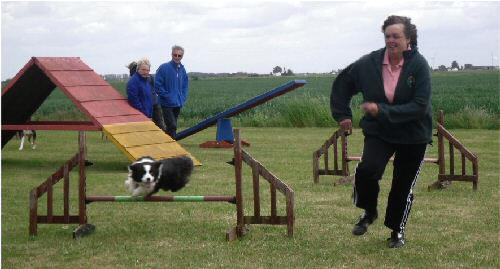McTimoney & Performance
|
|
|
|
Can it really affect a dog’s speed?
|
|
If these three things are performed effectively, then maximum speed can be achieved.
So
how was the study run? To try and align to best practice in clinical trial design, the study was set up to be randomised, double-blinded and controlled. But what does this mean?
After completing their set of runs, the dogs were separated from their handlers or owners and nine of them were treated with chiropractic. The other nine did not receive treatment. The only two people who knew whether the dog had been treated or not were the chiropractor Wendy Willetts, and her assistant who took the dog from the handler/owner. One week later all dogs ran the same exact course again. |
Agility course design |
rvafield.jpg) What
did we measure?
What
did we measure?Two things:
Speed – The difference between the time the dog ran the course clockwise and anti-clockwise before and after treatment. The difference in the chiropractic group was compared to the difference found with the control group.
Position of two key bones – The atlas (first bone in the neck); and the pelvis (in two orientations: rotation (whether it was level) and tilt (whether one side was further back than the other side). We then looked to see if this affected the speed of the dog in either direction, i.e. anti-clockwise and clockwise.
Was there a difference?
We have to be careful
when interpreting the results due to the relatively small number of dogs in the study but, in
essence, yes there was a difference between
the group treated
with chiropractic and the control group which was not.
Chiropractic caused an increase in speed greater than that seen in the control group. There was a difference at a numerical level, even though it was not statistically significant, in the amount that the speed increased in both directions between the two study groups. However, more exciting was the large dog sub-population, where the increase in speed in the anti-clockwise direction was shown to be statistically significant (p<0.05) in the chiropractic group versus the control group.
 Also
the
position of the pelvis impacted speed. There appeared to be a relationship between the position
of the skeleton and directional speed. Using an odds ratio (OR) analysis, the orientation of
the pelvis upwards or forwards was over three times more likely to occur on the side that the
dog ran the slowest.
Also
the
position of the pelvis impacted speed. There appeared to be a relationship between the position
of the skeleton and directional speed. Using an odds ratio (OR) analysis, the orientation of
the pelvis upwards or forwards was over three times more likely to occur on the side that the
dog ran the slowest.
Want to know more? If this article has sparked an interest and you would like to know more or would be interested in holding a chiropractic clinic at your club, then please contact Tina on m. 07890 656237.
About the authors...
Tina Lowes (High Peak Chiropractic) is a registered chiropractor (GCC 03112) and
holds a Masters degree in Animal Manipulation, mainly practising in horses and dogs. She is a
member of the McTimoney Chiropractic Association in the Human and Animal Faculties, and the
Royal College of Chiropractors. She is also a qualified Equine Bodyworker.
Based in Derbyshire, Tina accompanies her daughters Penny and Lucinda on the agility circuit and can be frequently found at shows with the RVA crew.
Wendy Willetts is a registered human, canine and equine chiropractor in Stourbridge in the West Midlands. Wendy is an avid horse rider competing in dressage and attends weekly agility sessions with her black Labrador. Wendy can be contacted on m. 07711 643690.
Both Tina and Wendy trained at the McTimoney College of Chiropractic.
For more information on a career in chiropractic, please visit: www.mctimoney-college.ac.uk
Please note: in accordance with the Veterinary Act, chiropractic is always carried out with the permission of the animal’s veterinary surgeon.
First published 26 August 2013
|
[bottom.htm] © Copyright Agilitynet |